ESP Alfa Romeo Giulietta 2017 Owner's Manual
[x] Cancel search | Manufacturer: ALFA ROMEO, Model Year: 2017, Model line: Giulietta, Model: Alfa Romeo Giulietta 2017Pages: 212, PDF Size: 4.56 MB
Page 2 of 212
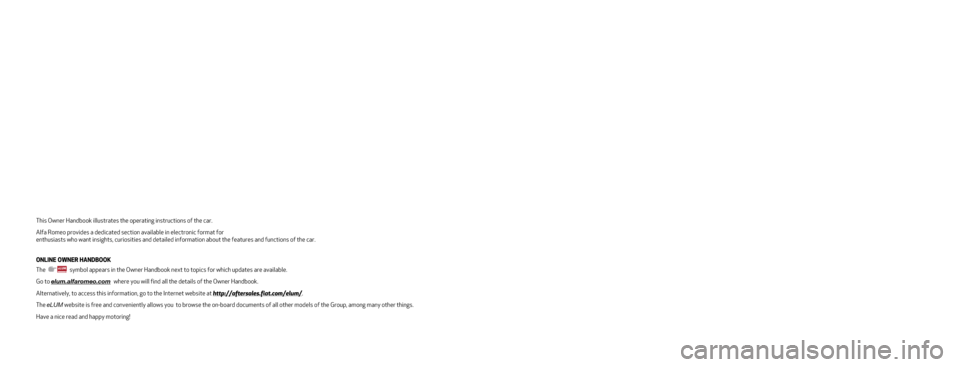
This Owner Handbook illustrates the operating instructions of the car.
Alfa Romeo provides a dedicated section available in electronic format f\
or
enthusiasts who want insights, curiosities and detailed information abou\
t the features and functions of the car.
ONLINE OWNER HANDBOOK
The symbol appears in the Owner Handbook next to topics for which updates ar\
e available.
Go to elum.alfaromeo.com
where you will find all the details of the Owner Handbook.
Alternatively, to access this information, go to the Internet website at\
http://aftersales.fiat.com/elum/
.
The eLUM website is free and conveniently allows you to browse the on-board docu\
ments of all other models of the Group, among many other things.
Have a nice read and happy motoring!
ALFA ROMEO GENUINE SPARE PARTS AND ACCESSORIES
PERFECT FOR YOUR VEHICLE, RIGHT DOWN TO THE SMALLEST DETAIL
The Alf
a Romeo Genuine Spare Parts and Accessories follow the rigid component engineering and manufacturing specifi cations
used in the assembly line to meet the technical specifi cations of your new Alfa Romeo and to enhance its style and performance. They undergo strict approval tests and quality controls to ensure they comply with safety and environmental standards.
All of the components on your new Alfa Romeo, from the smallest bulb to the most complex mechanical, electrical and electronic systems, are designed to work in harmony and guarantee you a comfortable and safe drive, in full respect for the environment. T he
Genuine Accessories fully enhance the style of your new vehicle.
Entrust the experience and quality of Alfa Romeo Dealerships to fi nd the full range of Alfa Romeo Genuine Spare Parts and
Accessories.
Find your nearest Dealership on www.alfaromeo.com
retro cop alfa giulia EN.qxp_500 UM ITA 16/12/15 09:26 Pagina 1
Page 4 of 212

READ THIS CAREFULLYREFUELLINGPetrol engines: only refuel with unleaded petrol with octane rating (RON) not less than 95 in compliance with the European specification EN228.
Diesel engines: refuel only with diesel fuel for motor vehicles conforming to the European specification EN590. The use of other products or
mixtures may damage the engine beyond repair and consequently invalidate the warranty, due to the damage caused.LPG engines: refuel only with
LPG for motor vehicles conforming to the European specification EN589. The use of other products or mixtures may damage the engine beyond
repair and consequently invalidate the warranty, due to the damage caused.
STARTING THE ENGINE
Petrol engines: make sure that the handbrake is engaged; set the gear lever to neutral; fully depress the clutch pedal without pressing the
accelerator, then turn the ignition key to AVV and release it as soon as the engine has started.Diesel engines: turn the ignition key to MAR and wait
for the
icon andwarning light to switch off. Then turn the ignition key to AVV and release it as soon as the engine has started.
PARKING ON FLAMMABLE MATERIAL
The catalytic converter develops high temperatures during operation. Do not park the car on grass, dry leaves, pine needles or other flammable
material: fire hazard.
RESPECTING THE ENVIRONMENT
The vehicle is fitted with a system that carries out a continuous diagnosis of the emission-related components in order to help protect the
environment.
ELECTRICAL ACCESSORIES
If, after buying the car, you decide to add electrical accessories (with the risk of gradually draining the battery), contact an Alfa Romeo Dealership.
They will calculate the overall electrical requirement and check that the car’s electrical system can support the required load.
SCHEDULED SERVICING
Correct maintenance of the car is essential for ensuring that it maintains its performance and its safety features, its environmental friendliness and
low running costs for a long time to come.
THE OWNER HANDBOOK CONTAINS
…important information, advice and warnings for correct use, driving safety and maintenance of the car over time. Special attention must be paid to
the symbols(personal safety)(environmental protection)(car integrity).
Page 5 of 212
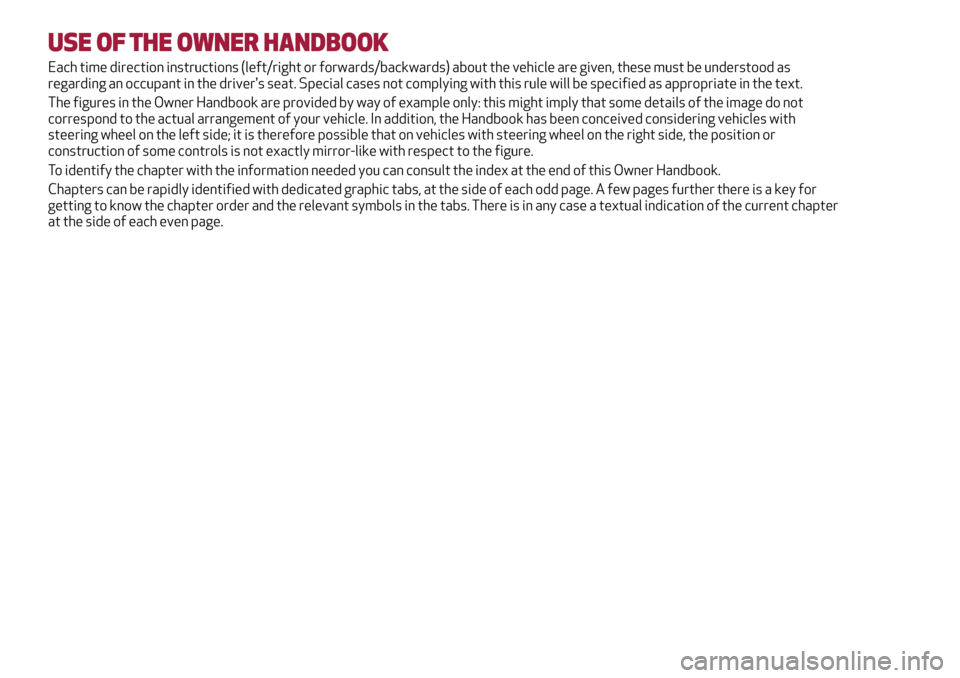
USE OF THE OWNER HANDBOOK
Each time direction instructions (left/right or forwards/backwards) about the vehicle are given, these must be understood as
regarding an occupant in the driver's seat. Special cases not complying with this rule will be specified as appropriate in the text.
The figures in the Owner Handbook are provided by way of example only: this might imply that some details of the image do not
correspond to the actual arrangement of your vehicle. In addition, the Handbook has been conceived considering vehicles with
steering wheel on the left side; it is therefore possible that on vehicles with steering wheel on the right side, the position or
construction of some controls is not exactly mirror-like with respect to the figure.
To identify the chapter with the information needed you can consult the index at the end of this Owner Handbook.
Chapters can be rapidly identified with dedicated graphic tabs, at the side of each odd page. A few pages further there is a key for
getting to know the chapter order and the relevant symbols in the tabs. There is in any case a textual indication of the current chapter
at the side of each even page.
Page 6 of 212
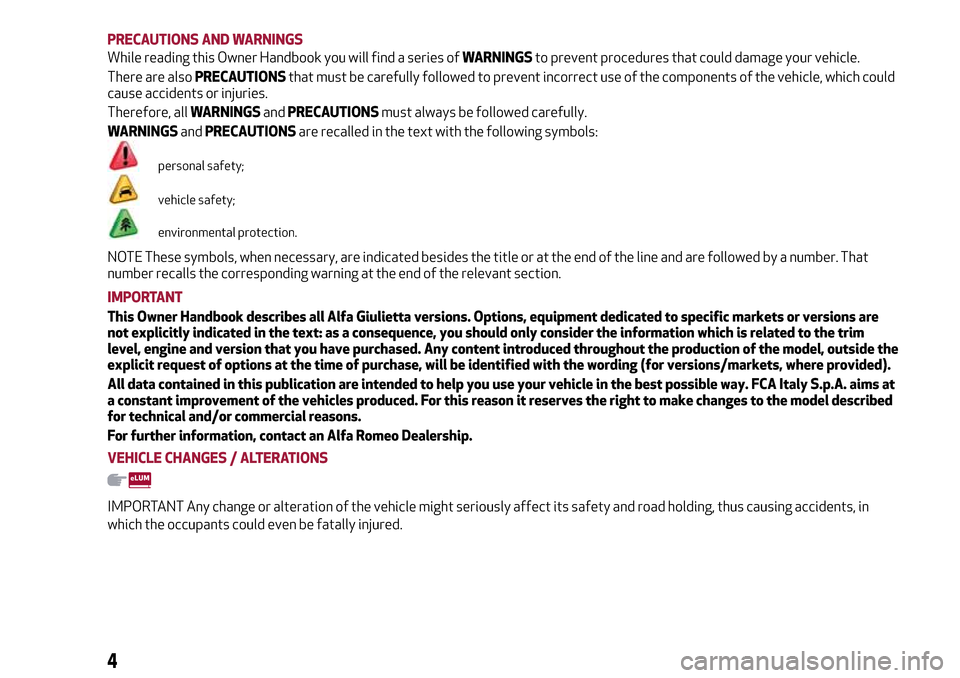
PRECAUTIONS AND WARNINGS
While reading this Owner Handbook you will find a series ofWARNINGSto prevent procedures that could damage your vehicle.
There are alsoPRECAUTIONSthat must be carefully followed to prevent incorrect use of the components of the vehicle, which could
cause accidents or injuries.
Therefore, allWARNINGSandPRECAUTIONSmust always be followed carefully.
WARNINGSandPRECAUTIONSare recalled in the text with the following symbols:
personal safety;
vehicle safety;
environmental protection.
NOTE These symbols, when necessary, are indicated besides the title or at the end of the line and are followed by a number. That
number recalls the corresponding warning at the end of the relevant section.
IMPORTANT
This Owner Handbook describes all Alfa Giulietta versions. Options, equipment dedicated to specific markets or versions are
not explicitly indicated in the text: as a consequence, you should only consider the information which is related to the trim
level, engine and version that you have purchased. Any content introduced throughout the production of the model, outside the
explicit request of options at the time of purchase, will be identified with the wording (for versions/markets, where provided).
All data contained in this publication are intended to help you use your vehicle in the best possible way. FCA Italy S.p.A. aims at
a constant improvement of the vehicles produced. For this reason it reserves the right to make changes to the model described
for technical and/or commercial reasons.
For further information, contact an Alfa Romeo Dealership.
VEHICLE CHANGES / ALTERATIONS
IMPORTANT Any change or alteration of the vehicle might seriously affect its safety and road holding, thus causing accidents, in
which the occupants could even be fatally injured.
4
Page 10 of 212
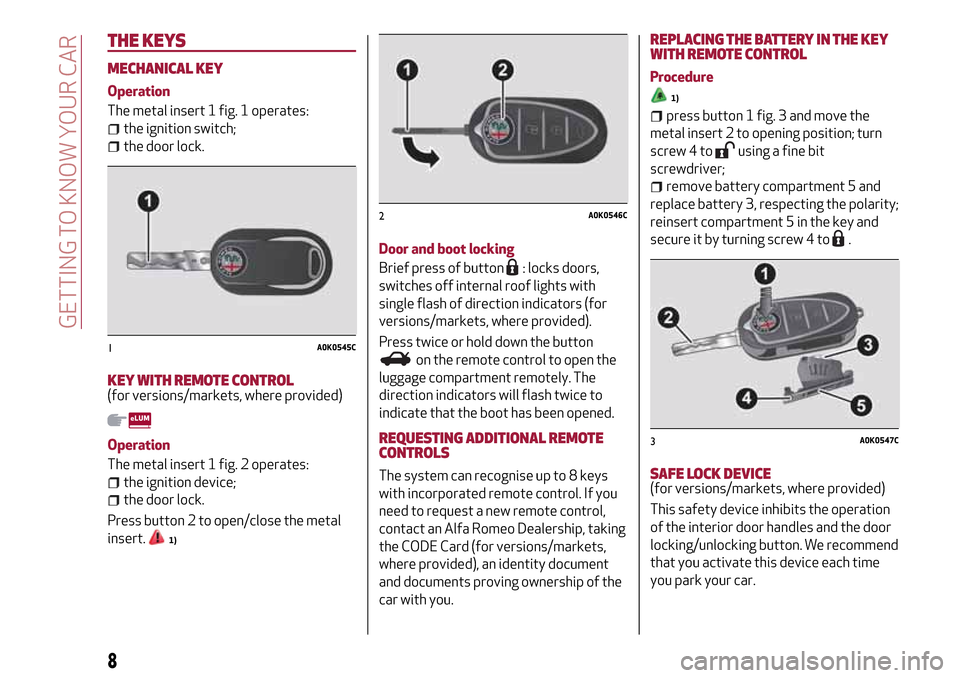
THE KEYS
MECHANICAL KEY
Operation
The metal insert 1 fig. 1 operates:
the ignition switch;
the door lock.
KEY WITH REMOTE CONTROL(for versions/markets, where provided)
Operation
The metal insert 1 fig. 2 operates:
the ignition device;
the door lock.
Press button 2 to open/close the metal
insert.
1)
Door and boot locking
Brief press of button
: locks doors,
switches off internal roof lights with
single flash of direction indicators (for
versions/markets, where provided).
Press twice or hold down the button
on the remote control to open the
luggage compartment remotely. The
direction indicators will flash twice to
indicate that the boot has been opened.
REQUESTING ADDITIONAL REMOTE
CONTROLS
The system can recognise up to 8 keys
with incorporated remote control. If you
need to request a new remote control,
contact an Alfa Romeo Dealership, taking
the CODE Card (for versions/markets,
where provided), an identity document
and documents proving ownership of the
car with you.
REPLACING THE BATTERY IN THE KEY
WITH REMOTE CONTROL
Procedure
1)
press button 1 fig. 3 and move the
metal insert 2 to opening position; turn
screw 4 to
using a fine bit
screwdriver;
remove battery compartment 5 and
replace battery 3, respecting the polarity;
reinsert compartment 5 in the key and
secure it by turning screw 4 to
.
SAFE LOCK DEVICE(for versions/markets, where provided)
This safety device inhibits the operation
of the interior door handles and the door
locking/unlocking button. We recommend
that you activate this device each time
you park your car.
1A0K0545C
2A0K0546C
3A0K0547C
8
GETTING TO KNOW YOUR CAR
Page 11 of 212
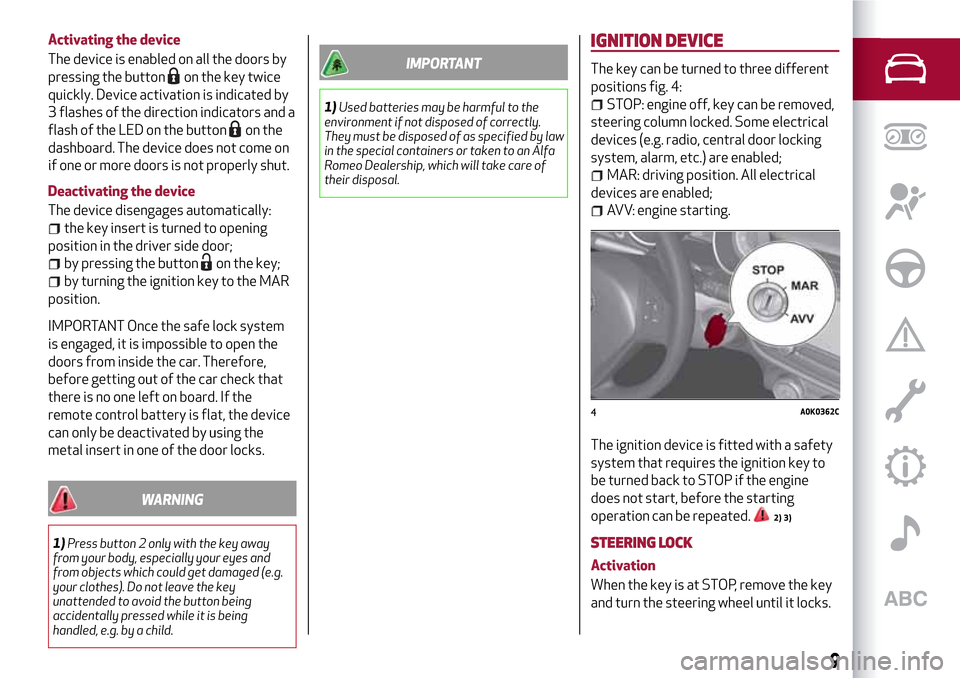
Activating the device
The device is enabled on all the doors by
pressing the button
on the key twice
quickly. Device activation is indicated by
3 flashes of the direction indicators and a
flash of the LED on the button
on the
dashboard. The device does not come on
if one or more doors is not properly shut.
Deactivating the device
The device disengages automatically:
the key insert is turned to opening
position in the driver side door;
by pressing the buttonon the key;
by turning the ignition key to the MAR
position.
IMPORTANT Once the safe lock system
is engaged, it is impossible to open the
doors from inside the car. Therefore,
before getting out of the car check that
there is no one left on board. If the
remote control battery is flat, the device
can only be deactivated by using the
metal insert in one of the door locks.
WARNING
1)Press button 2 only with the key away
from your body, especially your eyes and
from objects which could get damaged (e.g.
your clothes). Do not leave the key
unattended to avoid the button being
accidentally pressed while it is being
handled, e.g. by a child.
IMPORTANT
1)Used batteries may be harmful to the
environment if not disposed of correctly.
They must be disposed of as specified by law
in the special containers or taken to an Alfa
Romeo Dealership, which will take care of
their disposal.
IGNITION DEVICE
The key can be turned to three different
positions fig. 4:
STOP: engine off, key can be removed,
steering column locked. Some electrical
devices (e.g. radio, central door locking
system, alarm, etc.) are enabled;
MAR: driving position. All electrical
devices are enabled;
AVV: engine starting.
The ignition device is fitted with a safety
system that requires the ignition key to
be turned back to STOP if the engine
does not start, before the starting
operation can be repeated.
2) 3)
STEERING LOCK
Activation
When the key is at STOP, remove the key
and turn the steering wheel until it locks.
4A0K0362C
9
Page 27 of 212
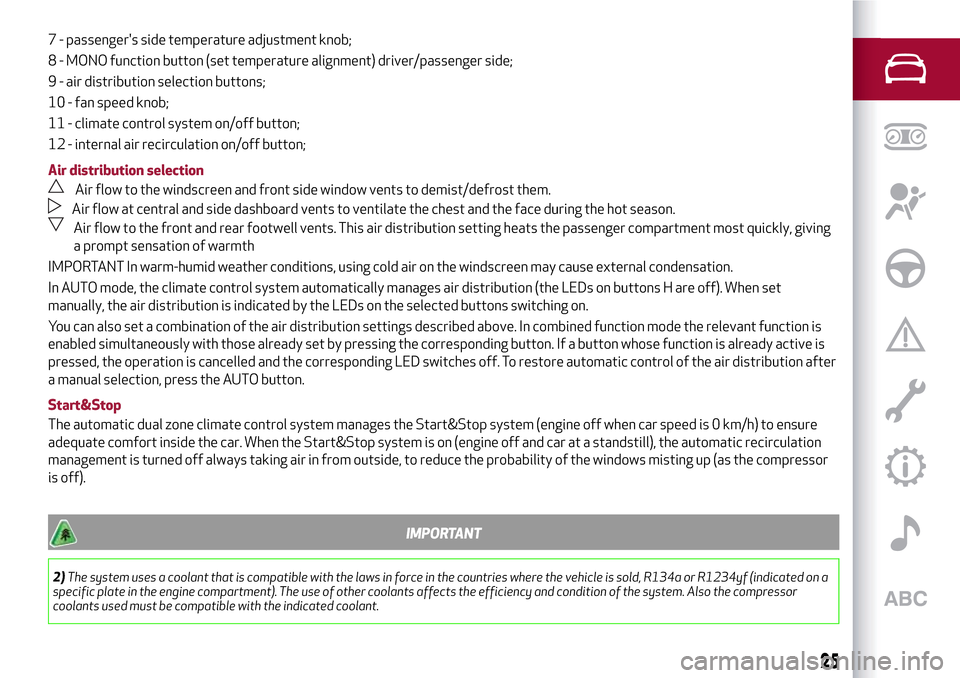
7 - passenger's side temperature adjustment knob;
8 - MONO function button (set temperature alignment) driver/passenger side;
9 - air distribution selection buttons;
10 - fan speed knob;
11 - climate control system on/off button;
12 - internal air recirculation on/off button;
Air distribution selection
Air flow to the windscreen and front side window vents to demist/defrost them.
Air flow at central and side dashboard vents to ventilate the chest and the face during the hot season.
Air flow to the front and rear footwell vents. This air distribution setting heats the passenger compartment most quickly, giving
a prompt sensation of warmth
IMPORTANT In warm-humid weather conditions, using cold air on the windscreen may cause external condensation.
In AUTO mode, the climate control system automatically manages air distribution (the LEDs on buttons H are off). When set
manually, the air distribution is indicated by the LEDs on the selected buttons switching on.
You can also set a combination of the air distribution settings described above. In combined function mode the relevant function is
enabled simultaneously with those already set by pressing the corresponding button. If a button whose function is already active is
pressed, the operation is cancelled and the corresponding LED switches off. To restore automatic control of the air distribution after
a manual selection, press the AUTO button.
Start&Stop
The automatic dual zone climate control system manages the Start&Stop system (engine off when car speed is 0 km/h) to ensure
adequate comfort inside the car. When the Start&Stop system is on (engine off and car at a standstill), the automatic recirculation
management is turned off always taking air in from outside, to reduce the probability of the windows misting up (as the compressor
is off).
IMPORTANT
2)The system uses a coolant that is compatible with the laws in force in the countries where the vehicle is sold, R134a or R1234yf (indicated on a
specific plate in the engine compartment). The use of other coolants affects the efficiency and condition of the system. Also the compressor
coolants used must be compatible with the indicated coolant.
25
Page 33 of 212
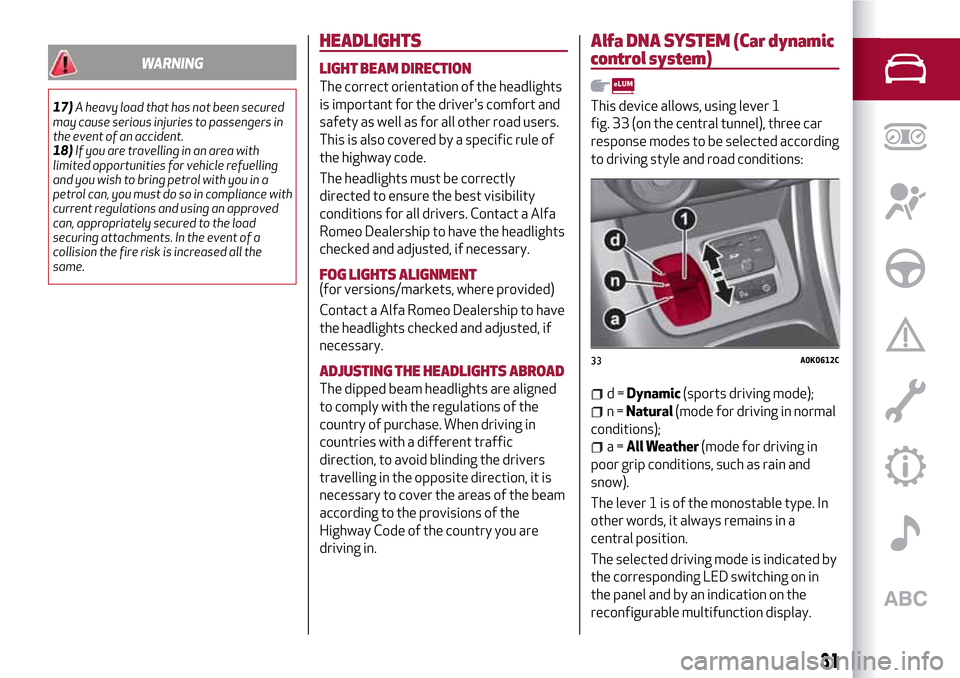
WARNING
17)A heavy load that has not been secured
may cause serious injuries to passengers in
the event of an accident.
18)If you are travelling in an area with
limited opportunities for vehicle refuelling
and you wish to bring petrol with you in a
petrol can, you must do so in compliance with
current regulations and using an approved
can, appropriately secured to the load
securing attachments. In the event of a
collision the fire risk is increased all the
same.
HEADLIGHTS
LIGHT BEAM DIRECTION
The correct orientation of the headlights
is important for the driver's comfort and
safety as well as for all other road users.
This is also covered by a specific rule of
the highway code.
The headlights must be correctly
directed to ensure the best visibility
conditions for all drivers. Contact a Alfa
Romeo Dealership to have the headlights
checked and adjusted, if necessary.
FOG LIGHTS ALIGNMENT(for versions/markets, where provided)
Contact a Alfa Romeo Dealership to have
the headlights checked and adjusted, if
necessary.
ADJUSTING THE HEADLIGHTS ABROAD
The dipped beam headlights are aligned
to comply with the regulations of the
country of purchase. When driving in
countries with a different traffic
direction, to avoid blinding the drivers
travelling in the opposite direction, it is
necessary to cover the areas of the beam
according to the provisions of the
Highway Code of the country you are
driving in.
Alfa DNASYSTEM (Car dynamic
control system)
This device allows, using lever 1
fig. 33 (on the central tunnel), three car
response modes to be selected according
to driving style and road conditions:
d=Dynamic(sports driving mode);
n=Natural(mode for driving in normal
conditions);
a=All Weather(mode for driving in
poor grip conditions, such as rain and
snow).
The lever 1 is of the monostable type. In
other words, it always remains in a
central position.
The selected driving mode is indicated by
the corresponding LED switching on in
the panel and by an indication on the
reconfigurable multifunction display.
33A0K0612C
31
Page 34 of 212
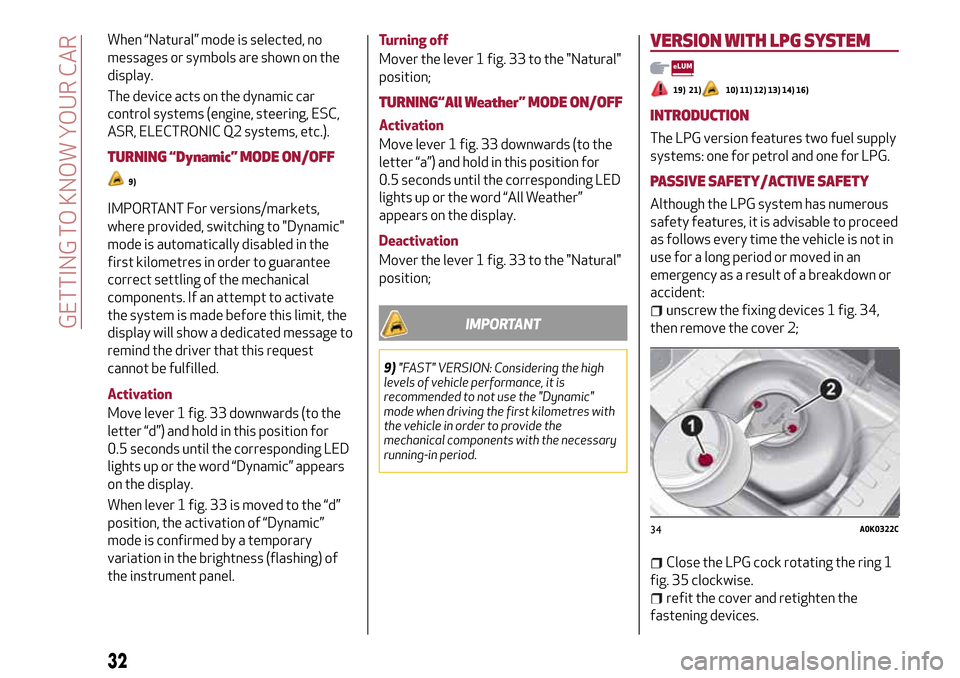
When “Natural” mode is selected, no
messages or symbols are shown on the
display.
The device acts on the dynamic car
control systems (engine, steering, ESC,
ASR, ELECTRONIC Q2 systems, etc.).
TURNING “Dynamic” MODE ON/OFF
9)
IMPORTANT For versions/markets,
where provided, switching to "Dynamic"
mode is automatically disabled in the
first kilometres in order to guarantee
correct settling of the mechanical
components. If an attempt to activate
the system is made before this limit, the
display will show a dedicated message to
remind the driver that this request
cannot be fulfilled.
Activation
Move lever 1 fig. 33 downwards (to the
letter “d”) and hold in this position for
0.5 seconds until the corresponding LED
lights up or the word “Dynamic” appears
on the display.
When lever 1 fig. 33 is moved to the “d”
position, the activation of “Dynamic”
mode is confirmed by a temporary
variation in the brightness (flashing) of
the instrument panel.Turning off
Mover the lever 1 fig. 33 to the "Natural"
position;
TURNING“All Weather” MODE ON/OFF
Activation
Move lever 1 fig. 33 downwards (to the
letter “a”) and hold in this position for
0.5 seconds until the corresponding LED
lights up or the word “All Weather”
appears on the display.
Deactivation
Mover the lever 1 fig. 33 to the "Natural"
position;
IMPORTANT
9)"FAST" VERSION: Considering the high
levels of vehicle performance, it is
recommended to not use the "Dynamic"
mode when driving the first kilometres with
the vehicle in order to provide the
mechanical components with the necessary
running-in period.
VERSION WITH LPGSYSTEM
19) 21)10) 11) 12) 13) 14) 16)
INTRODUCTION
The LPG version features two fuel supply
systems: one for petrol and one for LPG.
PASSIVE SAFETY/ACTIVE SAFETY
Although the LPG system has numerous
safety features, it is advisable to proceed
as follows every time the vehicle is not in
use for a long period or moved in an
emergency as a result of a breakdown or
accident:
unscrew the fixing devices 1 fig. 34,
then remove the cover 2;
Close the LPG cock rotating the ring 1
fig. 35 clockwise.
refit the cover and retighten the
fastening devices.
34A0K0322C
32
GETTING TO KNOW YOUR CAR
Page 62 of 212
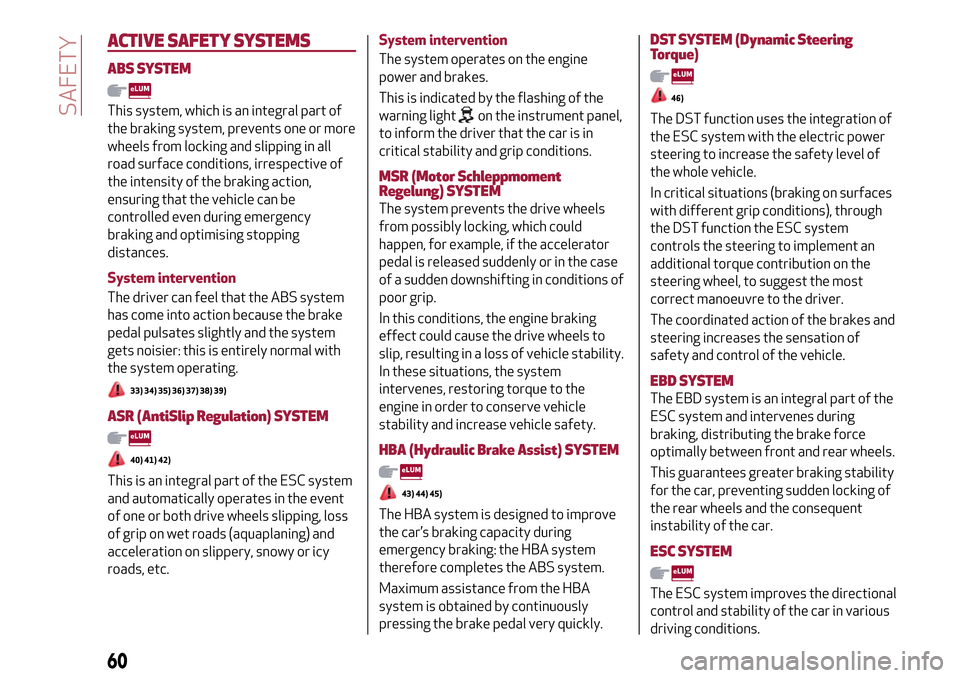
ACTIVE SAFETYSYSTEMS
ABS SYSTEM
This system, which is an integral part of
the braking system, prevents one or more
wheels from locking and slipping in all
road surface conditions, irrespective of
the intensity of the braking action,
ensuring that the vehicle can be
controlled even during emergency
braking and optimising stopping
distances.
System intervention
The driver can feel that the ABS system
has come into action because the brake
pedal pulsates slightly and the system
gets noisier: this is entirely normal with
the system operating.
33) 34) 35) 36) 37) 38) 39)
ASR (AntiSlip Regulation)SYSTEM
40) 41) 42)
This is an integral part of the ESC system
and automatically operates in the event
of one or both drive wheels slipping, loss
of grip on wet roads (aquaplaning) and
acceleration on slippery, snowy or icy
roads, etc.System intervention
The system operates on the engine
power and brakes.
This is indicated by the flashing of the
warning light
on the instrument panel,
to inform the driver that the car is in
critical stability and grip conditions.
MSR (Motor Schleppmoment
Regelung)SYSTEM
The system prevents the drive wheels
from possibly locking, which could
happen, for example, if the accelerator
pedal is released suddenly or in the case
of a sudden downshifting in conditions of
poor grip.
In this conditions, the engine braking
effect could cause the drive wheels to
slip, resulting in a loss of vehicle stability.
In these situations, the system
intervenes, restoring torque to the
engine in order to conserve vehicle
stability and increase vehicle safety.
HBA (Hydraulic Brake Assist)SYSTEM
43) 44) 45)
The HBA system is designed to improve
the car’s braking capacity during
emergency braking: the HBA system
therefore completes the ABS system.
Maximum assistance from the HBA
system is obtained by continuously
pressing the brake pedal very quickly.
DST SYSTEM (Dynamic Steering
Torque)
46)
The DST function uses the integration of
the ESC system with the electric power
steering to increase the safety level of
the whole vehicle.
In critical situations (braking on surfaces
with different grip conditions), through
the DST function the ESC system
controls the steering to implement an
additional torque contribution on the
steering wheel, to suggest the most
correct manoeuvre to the driver.
The coordinated action of the brakes and
steering increases the sensation of
safety and control of the vehicle.
EBD SYSTEM
The EBD system is an integral part of the
ESC system and intervenes during
braking, distributing the brake force
optimally between front and rear wheels.
This guarantees greater braking stability
for the car, preventing sudden locking of
the rear wheels and the consequent
instability of the car.
ESC SYSTEM
The ESC system improves the directional
control and stability of the car in various
driving conditions.
60
SAFETY